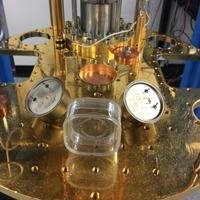
Friday, 28 November 2014
A coin-sized detector might observe gravitational waves before the giant Laser Interferometer Gravitational-Wave Observatory (LIGO), according to two Australian physicists.
Predicted by Einstein's general theory of relativity but yet to be directly observed, gravitational waves are ripples in space-time generated by accelerating massive objects. The tiny detector has been made by Dr Maxim Goryachev and Professor Michael Tobar at The University of Western Australia.
Resonant-mass detectors have traditionally employed metal bars about a metre long and around a tonne in weight, which makes them sensitive to gravitational waves with frequencies up to about a few kilohertz. However, tiny vibrations that would be induced by gravitational waves are extremely difficult to detect above the thermal noise in the bar.
Dr Goryachev and Professor Tobar overcame this problem by targeting gravitational radiation in the 1-1000 MHz range. Operating at temperatures as low as 0.01 K above the absolute zero, these devices are able to operate at the quantum regime allowing for the lowest possible noise level.
Their device consists of a quartz disc about 2.5 cm in diameter hinged to another piece of quartz and placed in a vacuum chamber. A passing high-frequency gravitational wave would cause the disc to vibrate, setting up standing waves of sound across the 2 mm thickness of the disc.
The upper surface of the disc is slightly curved to trap sound quanta (phonons), which improves the signal-to-noise ratio. The nature of quartz allows the tiny vibrations to be converted into an electrical signal that is amplified by the extremely low-noise Superconducting Quantum Interference Device (SQUID) amplifiers.
Having accounted for all known sources of noise, Dr Goryachev and Professor Tobar believe their detector would be sensitive to strains in space-time as low as 10 - 22 per share root of Hertz, the figure that Advanced LIGO is set to achieve.
Advanced LIGO is an upgrade of two existing LIGO detectors in the US, which are searching for gravitational waves. The huge detectors are expected to detect signals between about 0.1-1 kHz, from sources such as binary neutron stars or colliding black holes by the end of 2018.
Dr Goryachev and Professor Tobar say that their device is able to detect gravitational waves from some candidates such as axions and preons forming tiny stars and black holes.
The setup is also able to put limits on gravitational radiation from the early Universe predicted by some Big Bang theories.
The paper: Gravitational wave detection with high frequency phonon trapping acoustic cavities has been published in APS Physics .
Media references
Professor Mike Tobar
(UWA School of Physics) (+61 8) 6488 3443 / (+61 4) 04 872 944
Dr Maxim Goryachev
(UWA School of Physics) (+61 8) 6488 3606
David Stacey
(UWA Media Manager) (+61 8) 6488 3229 / (+61 4) 32 637 716
Tags
- Channels
- International — Media Statements — Research — University News
- Groups
- School of Physics — Science Matters